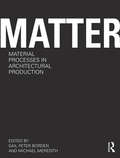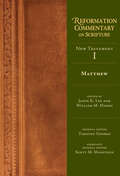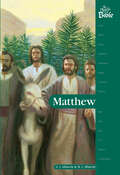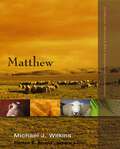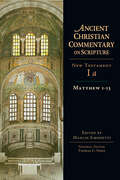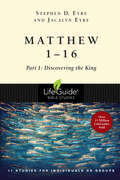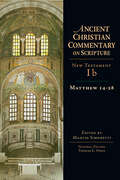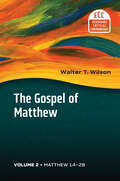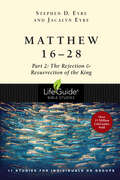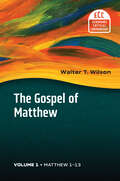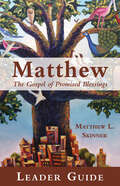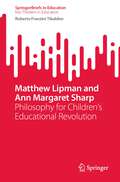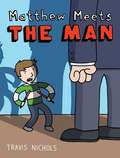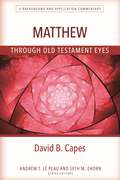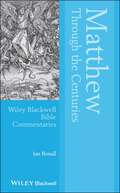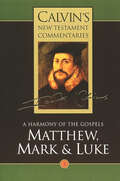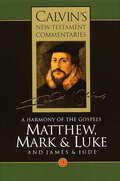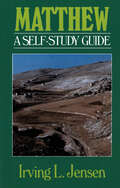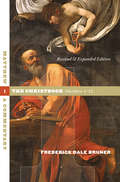- Table View
- List View
Matter and Method in Education (Routledge Library Editions: Education)
by Mary SturtThis volume discusses school practice and methods in the early twentieth century against their historical background. It covers the curriculum, time-tabling, lesson planning, exams and discipline. Each chapter ends with extensive notes and questions for discussion.
Matter: Material Processes in Architectural Production
by Michael Meredith Gail Peter BordenBeginning with material, this book revolves around physical material making and design decisions that emerge from material interaction. Combining essays from both practice and academia, this book presents some of the most significant projects and thoughts on materiality from the last decade. Beautifully illustrated with a great deal of technical information throughout, it shows work, technical technique and process, and positions it within a broader theoretical intention. By assembling a range of voices, here is a multifaceted portrait of material design today. Students and design professionals alike should find in this book an essential resource for understanding this increasingly important aspect of design.
Matthew (Reformation Commentary on Scripture #Nt Volume 1)
by William M. Marsh Jason K. Lee, William M. Marsh Jason K. Lee"As they were eating, Jesus took bread, and after blessing it broke it and gave it to the disciples, and said, 'Take, eat; this is my body.'" How should one interpret these words of Jesus? The sixteenth-century Reformers turned to Scripture to find the truth of God's Word, but that doesn't mean they always agreed on how to interpret it. For example, when approaching this passage from Matthew's gospel, Martin Luther read it literally, for "as he says in his own words, it is his body and his blood," but Thomas Cranmer argued that "there must be some figure or mystery in this speech." In this Reformation Commentary on Scripture volume, scholars Jason K. Lee and William Marsh guide readers through a wealth of early modern commentary on the book of Matthew. Readers will hear from familiar voices and discover lesser-known figures from a diversity of theological traditions, including Lutherans, Reformed, Radicals, Anglicans and Roman Catholics. Drawing upon a variety of resources—including commentaries, sermons, treatises, and confessions—much of which appears here for the first time in English, this volume provides resources for contemporary preachers, enables scholars to better understand the depth and breadth of Reformation commentary, and seeks to encourage all those who desire to read the words of Scripture faithfully.
Matthew (The Church's Bible #V. 125)
by D. H. WilliamsSelect ancient Christian writings on the Gospel of MatthewThe Church&’s Bible series brings the rich classical tradition of biblical interpretation to life, illuminating Scripture as it was understood during the first millennium of Christian history. Compiled, translated, and edited by leading scholars, these volumes lead contemporary clergy, Bible teachers, and students of Scripture into the inexhaustible spiritual and theological world of the early church.This volume on Matthew contains select freshly translated excerpts from patristic commentators including John Chrysostom, Irenaeus of Lyons, Origen, Tertullian, and Augustine. Ranging chronologically from the second century to the seventh century, these selections splendidly display a neglected part of the church&’s interpretive tradition on Matthew.
Matthew (The Church's Bible #V. 125)
by D. H. WilliamsSelect ancient Christian writings on the Gospel of MatthewThe Church’s Bible series brings the rich classical tradition of biblical interpretation to life, illuminating Scripture as it was understood during the first millennium of Christian history. Compiled, translated, and edited by leading scholars, these volumes lead contemporary clergy, Bible teachers, and students of Scripture into the inexhaustible spiritual and theological world of the early church.This volume on Matthew contains select freshly translated excerpts from patristic commentators including John Chrysostom, Irenaeus of Lyons, Origen, Tertullian, and Augustine. Ranging chronologically from the second century to the seventh century, these selections splendidly display a neglected part of the church’s interpretive tradition on Matthew.
Matthew (The People's Bible)
by G Jerome Albrecht Michael J AlbrechtWho was Matthew in the Bible?When Matthew left his tax collector’s booth in Galilee to follow Jesus, he became an eyewitness to the Savior’s ministry. His record gives the teachings of Jesus special attention and assures believers that Jesus is the Messiah foretold by so many Old Testament prophecies. For these reasons, his gospel has become the first book of the New Testament.Want to learn more? If you’re wondering what the book of Matthew is all about, this helpful resource is for you!Matthew is a reliable Bible commentary. It’s down to earth, clearly written, easy to read and understand, and filled with practical and modern applications to Scripture.It also includes the complete text of the book of Matthew from the NIV Bible. The Christ-centered commentaries following the Scripture sections contain explanations of the text, historical background, illustrations, and archaeological information. Matthew is a great resource for personal or group study!This book is a part of The People’s Bible series from Northwestern Publishing House.
Matthew (Zondervan Illustrated Bible Backgrounds Commentary)
by Michael J. WilkinsBrimming with lavish, full-color photos and graphics, the Zondervan Illustrated Bible Backgrounds Commentary walks you verse by verse through all the books of the New Testament. It’s like slipping on a set of glasses that lets you read the Bible through the eyes of a first-century reader! Discoveries await you that will snap the world of the New Testament into gripping immediacy. Things that seem mystifying, puzzling, or obscure will take on tremendous meaning when you view them in their ancient context. You’ll deepen your understanding of the teachings of Jesus. You’ll discover the close, sometimes startling interplay between God’s kingdom and the practical affairs of the church. Best of all, you’ll gain a deepened awareness of the Bible’s relevance for your life. Written in a clear, engaging style, this beautiful set provides a new and accessible approach that more technical expository and exegetical commentaries don’t offer.
Matthew 1-13 (Ancient Christian Commentary on Scripture #Nt Volume 1a)
by Thomas C. OdenOpus imperfectum in Matthaeum.catena
Matthew 1-16: Part 1: Discovering the King (LifeGuide Bible Studies)
by Jacalyn Eyre Stephen D. EyreWhat would it be like to be discipled by Jesus himself? What would he teach you about relationships, priorities, wealth and his coming kingdom? What would you learn from his actions? Matthew's Gospel brings you face to face with Jesus as he calls, teaches and prepares his disciples. As you work through these eleven-session LifeGuide Bible Study on Matthew, you can become one of those chosen followers. This LifeGuide Bible Study features questions for starting group discussions and for meeting God in personal reflection. Leader's notes are included with information on study preparation, leading the study and small group components as well as helps for specific Bible passages covered in the study. Presented in a convenient workbook format and featuring the inductive Bible study approach, LifeGuides are thoroughly field-tested prior to publication; they're proven and popular guides for digging into Scripture on your own or with a small group. For over three decades LifeGuide Bible Studies have provided solid biblical content and raised thought-provoking questions���making for a one-of-a-kind Bible study experience for individuals and groups. This series has more than 130 titles on Old and New Testament books, character studies, and topical studies. PDF download with a single-user license; available from InterVarsity Press and other resellers.
Matthew 14-28 (Ancient Christian Commentary on Scripture #Nt Volume 1b)
by Thomas C. OdenThe Gospel of Matthew stands out as a favorite biblical text among patristic commentators. The patristic commentary tradition on Matthew begins with Origen's pioneering twenty-five-volume commentary on the First Gospel in the mid-third century. In the Latin-speaking West, where commentaries did not appear until about a century later, the first commentary on Matthew was written by Hilary of Poitiers in the mid-fourth century. From that point the First Gospel became one of the texts most frequently commented on in patristic exegesis. Outstanding examples are Jerome's four-volume commentary and the valuable but anonymous and incomplete Opus imperfectum in Matthaeum. Then there are the Greek catena fragments derived from commentaries by Theodore of Heraclea, Apollinaris of Laodicea, Theodore of Mopsuestia and Cyril of Alexandria. The ancient homilies also provide ample comment, including John Chrysostom's ninety homilies and Chromatius of Aquileia's fifty-nine homilies on the Gospel of Matthew. In addition, there are various Sunday and feast-day homilies from towering figures such as Augustine and Gregory the Great, as well as other fathers. This rich abundance of patristic comment, much of it presented here in English translation for the first time by editor Manlio Simonetti, provides a bountiful and varied feast of ancient interpretation of the First Gospel.
Matthew 14–28: The Gospel of Matthew, vol 2 (Eerdmans Critical Commentary)
by Walter T. WilsonWhat was the original purpose of the Gospel of Matthew? For whom was it written? In this magisterial two-volume commentary, Walter Wilson interprets Matthew as a catechetical work that expresses the ideological and institutional concerns of a faction of disaffected Jewish followers of Jesus in the late first century CE. Wilson&’s compelling thesis frames Matthew&’s Gospel as not only a continuation of the biblical story but also as a didactic narrative intended to shape the commitments and identity of a particular group that saw itself as a beleaguered, dissident minority. Thus, the text clarifies Jesus&’s essential Jewish character as the &“Son of David&” while also portraying him in opposition to prominent religious leaders of his day—most notably the Pharisees—and open to cordial association with non-Jews.Through meticulous engagement with the Greek text of the Gospel, as well as relevant primary sources and secondary literature, Wilson offers a wealth of insight into the first book of the New Testament. After an introduction exploring the background of the text, its genre and literary features, and its theological orientation, Wilson explicates each passage of the Gospel with thorough commentary on the intended message to first-century readers about topics like morality, liturgy, mission, group discipline, and eschatology. Scholars, students, pastors, and all readers interested in what makes the Gospel of Matthew distinctive among the Synoptics will appreciate and benefit from Wilson&’s deep contextualization of the text, informed by his years of studying the New Testament and Christian origins.
Matthew 16-28: Part 2: The Rejection & Resurrection of the King (LifeGuide Bible Studies)
by Jacalyn Eyre Stephen D. EyreWhat would it be like to be discipled by Jesus himself? What would he teach you about relationships, priorities, wealth and his coming kingdom? What would you learn from his actions? Matthew's Gospel brings you face to face with Jesus as he calls, teaches and prepares his disciples. As you work through these eleven-session LifeGuide Bible Study on Matthew, you can become one of those chosen followers. This LifeGuide Bible Study features questions for starting group discussions and for meeting God in personal reflection. Leader's notes are included with information on study preparation, leading the study and small group components as well as helps for specific Bible passages covered in the study. Presented in a convenient workbook format and featuring the inductive Bible study approach, LifeGuides are thoroughly field-tested prior to publication; they're proven and popular guides for digging into Scripture on your own or with a small group. For over three decades LifeGuide Bible Studies have provided solid biblical content and raised thought-provoking questions���making for a one-of-a-kind Bible study experience for individuals and groups. This series has more than 130 titles on Old and New Testament books, character studies, and topical studies. PDF download with a single-user license; available from InterVarsity Press and other resellers.
Matthew 1–13: The Gospel of Matthew, vol 1 (Eerdmans Critical Commentary)
by Walter T. WilsonWhat was the original purpose of the Gospel of Matthew? For whom was it written? In this magisterial two-volume commentary, Walter Wilson interprets Matthew as a catechetical work that expresses the ideological and institutional concerns of a faction of disaffected Jewish followers of Jesus in the late first century CE. Wilson&’s compelling thesis frames Matthew&’s Gospel as not only a continuation of the biblical story but also as a didactic narrative intended to shape the commitments and identity of a particular group that saw itself as a beleaguered, dissident minority. Thus, the text clarifies Jesus&’s essential Jewish character as the &“Son of David&” while also portraying him in opposition to prominent religious leaders of his day—most notably the Pharisees—and open to cordial association with non-Jews.Through meticulous engagement with the Greek text of the Gospel, as well as relevant primary sources and secondary literature, Wilson offers a wealth of insight into the first book of the New Testament. After an introduction exploring the background of the text, its genre and literary features, and its theological orientation, Wilson explicates each passage of the Gospel with thorough commentary on the intended message to first-century readers about topics like morality, liturgy, mission, group discipline, and eschatology. Scholars, students, pastors, and all readers interested in what makes the Gospel of Matthew distinctive among the Synoptics will appreciate and benefit from Wilson&’s deep contextualization of the text, informed by his years of studying the New Testament and Christian origins.
Matthew A. B. C.
by Peter CatalanottoWho is missing from Mrs. Tuttle's kindergarten class? Will he fit in as well as the other 25?
Matthew Leader Guide: The Gospel of Promised Blessings
by Matthew L. SkinnerExplore the tenderness and the tensions in the teachings of Jesus. The Leader Guide contains everything needed to guide a group through the six-week study, including session plans, activities, discussion questions, and multiple format options. Components include the book, Matthew: The Gospel of Promised Blessings, and video teaching sessions featuring Matthew Skinner. The Gospel of Matthew portrays Jesus and his message as full of tender compassion and urgent warning. This six-part exploration of an enigmatic Gospel takes readers into the themes, topics, and tensions at the heart of Matthew's story about the life and work of Jesus. Chapters focus on blessing and comfort, judgment and retribution, the meaning of discipleship, Jesus’ vision for the Church and world, conflicts and complaints, and how the Gospel of Matthew speaks to believers today.
Matthew Lipman and Ann Margaret Sharp: Philosophy for Children’s Educational Revolution (SpringerBriefs in Education)
by Roberto Franzini TibaldeoThis book explores the contribution to education contained in the theoretical work and teaching practice of Matthew Lipman (1923-2010) and Ann Margaret Sharp (1942-2010). Their long-lasting cooperation gave rise to the well-known “Philosophy for Children” (P4C) curriculum, which is nowadays globally widespread. P4C basically relies on the following innovations: firstly, the unprecedented connection between philosophy and childhood; secondly, the reframing of philosophy in practical, viz., not reductively theoretical terms; thirdly, the employment of philosophy to foster democracy and moral capabilities through the development of children’s thoughtfulness and autonomous thinking, which would eventually result in empowering children’s social abilities and increasing their self-defence against consumerism, propaganda, and manipulation; finally, the stand against a strictly cognitivist approach to education. More than just contextualizing these innovations in the coeval historical and social context, the author shows that P4C’s revolutionary stance on education relies on the fruitfulness of Lipman and Sharp’s intellectual cooperation and on their manifold abilities as researchers, teachers, trainers, communicators, motivators, and community-builders. The book analyzes their philosophical-educational vision and the scholastic curriculum they developed jointly; additionally, it provides a critical appraisal of P4C’s achievements as well as of its future perspectives.
Matthew Meets the Man
by Travis NicholsMatthew Swanbeck has a classic problem. Back in seventh grade, his dad talked him into playing the trumpet instead of the drums. Now he's a lowly brass player in the school marching band. Until one day he has an epiphany: He can start his own band, play in all the cool rock venues, even go on tour . . . if only he can scrape together the cash to buy a drum set. But how will he ever get the money together when The Man thwarts him at every turn, taking taxes out of his paycheck, forcing him to mow the lawn for a measly $10 a week, and creating all of those rules that get in the way of dreams? It's one teen against the system in this light-hearted look at the challenges and rewards of chasing your dreams.
Matthew Through Old Testament Eyes (Through Old Testament Eyes Series)
by David B. CapesThrough Old Testament Eyes is a new kind of commentary series that illuminates the Old Testament backgrounds, allusions, patterns, and references that saturate the New Testament. These links were second nature to the New Testament authors and their audiences, but today's readers often cannot see them. Bible teachers, preachers, and students committed to understanding Scripture will gain insight through these rich Old Testament connections, which clarify puzzling passages and explain others in fresh ways. The Gospel of Matthew contains both overt and subtle connections to the Old Testament, capitalizing on the scriptural literacy of the work's original, first-century Jewish audience. These complex and multifaceted connections are not always recognized by today's readers, meaning significant ideas can be easily missed or misappropriated. David B. Capes elucidates these extensive backgrounds, echoes, quotations, ways of thinking, and patterns of living, showing how God's plan--introduced in the Hebrew Scriptures--is revealed through the very person, work, life, and ministry of Jesus. Avoiding overly technical discussions and interpretive debates to concentrate on Old Testament influences, this book combines rigorous, focused New Testament scholarship with deep respect for the entire biblical text.
Matthew Through the Centuries (Wiley Blackwell Bible Commentaries)
by Ian BoxallThe reception of the Gospel of Matthew over two millennia: commentary and interpretation Matthew Through the Centuries offers an overview of the reception history of one of the most prominent gospels in Christian worship. Examining the reception of Matthew from the perspectives of a wide range of interpreters—from Origen and Hilary of Poitiers to Mary Cornwallis and Bob Marley—this insightful commentary explains the major trends in the reception of Matthew in various ecclesial, historical, and cultural contexts. Focusing on characteristically Matthean features, detailed chapter-by-chapter commentary highlights diverse receptions and interpretations of the gospel. Broad exploration of areas such as liturgy, literature, drama, film, hymnody, political discourse, and visual art illustrates the enormous impact Matthew continues to have on Judeo-Christian civilization. Known as ‘the Church’s Gospel,’ Matthew’s text has been the subject of apologetic and theological controversy for hundreds of years. It has been seen as justification for political and ecclesial status quo and as a path to radical discipleship. Matthew has influenced divergent political, spiritual, and cultural figures such as Francis of Assisi, John Ruskin, Leo Tolstoy, Dietrich Bonhoeffer, and Mahatma Gandhi. Matthew’s interest in ecclesiology provides early structures of ecclesial life, such as resolution of community disputes, communal prayer, and liturgical prescriptions for the Eucharist and baptism. A significant addition to the acclaimed Blackwell Bible Commentaries series, Matthew Through the Centuries is an indispensable resource for both students and experts in areas including religious and biblical studies, literature, history, politics, and those interested in the influence of the Bible on Western culture.
Matthew, Mark, & Luke: A Harmony of the Gospels (Calvin’s New Testament Commentaries (CNTC))
by John CalvinThis volume is one of twelve classic commentaries by John Calvin, theologian par excellence of the Reformation, whose expositions of Scripture remain as relevant as ever. Edited by David W. Torrance and Thomas F. Torrance, these twelve commentaries on the New Testament bring Calvin's authoritative voice to life in clear contemporary English. The translations all strive to retain the close coherence of Calvin's ideas and characteristic images while remaining faithful to the Latin text — doing full justice to the Reformer's qualities as one of history's finest expositors of the Word of God.
Matthew, Mark, & Luke: A Harmony of the Gospels (Calvin’s New Testament Commentaries (CNTC))
by John CalvinThis is a print on demand book and is therefore non- returnable. This volume is one of twelve classic commentaries by John Calvin, theologian par excellence of the Reformation, whose expositions of Scripture remain as relevant as ever. Edited by David W. Torrance and Thomas F. Torrance, these twelve commentaries on the New Testament bring Calvin's authoritative voice to life in clear contemporary English. The translations all strive to retain the close coherence of Calvin's ideas and characteristic images while remaining faithful to the Latin text — doing full justice to the Reformer's qualities as one of history's finest expositors of the Word of God.
Matthew- Teach Yourself the Bible Series: The Gospel of God's King (Teach Yourself the Bible)
by Keith L. BrooksMatthew's gospel is the bridge between Judaism and Christianity, presenting Jesus as the Messiah and mediator of the new covenant. Study the exciting changes that occur as Christian law replaces Levitical law, as the Lord's Supper replaces the Passover, and as the high priesthood of Jesus Christ replaces the old Aaronic priesthood.The Teach Yourself the Bible series is one of the best New Testament studies you will find anywhere. Each book in the series is packed full of valuable questions on individual chapters of the Bible, check-ups to test your grasp of biblical truths, and usable suggestions for group study.Grow in your knowledge of God through each New Testament book, then go on to study six aspects of Christianity essential for all believers: doctrine, prayer, eternal life, prophecy, Christian character, and Bible study.Strengthen your relationship with the living God with all twenty-five books of the Teach Yourself the Bible Series. Each volume is a timeless, yet practical, study of the Word of God.
Matthew: A Commentary, Volume 1
by Frederick Dale BrunerRecognized as a masterly commentary when it first appeared, Frederick Dale Bruner's study of Matthew is now available as a greatly revised and expanded two-volume work -- the result of seven years of careful refinement, enrichment, and updating.Through this commentary, crafted especially for teachers, pastors, and Bible students, Bruner aims "to help God's people love what Matthew's Gospel says." Bruner's work is at once broadly historical and deeply theological. It is historical in drawing extensively on great church teachers through the centuries and on the classical Christian creeds and confessions. It is theological in that it unpacks the doctrines in each passage, chapter, and section of the Gospel. Consciously attempting to bridge past and present, Bruner asks both what Matthew's Gospel said to its first hearers and what it says to readers today. As a result, his commentary is profoundly relevant to contemporary congregations and to those who guide them.Bruner's commentary is replete with lively, verse-by-verse discussion of Matthew's text. While each chapter expounds a specific topic or doctrine, the book's format consists of a vivid, original translation of the text followed by faithful exegesis and critical analysis, a survey of historical commentary on the text, and current applications of the text or theme under study. In this revision Bruner continues to draw on the best in modern scholarship -- including recent work by W. D. Davies and Dale C. Allison Jr., by Ulrich Luz, and by many others -- adding new voices to the reading of Matthew. At the same time he cites the classic commentaries of Chrysostom, Jerome, Augustine, Luther, Calvin, Bengel, and the rest, who, like Bruner himself, were not simply doctrinal teachers but also careful exegetes of Scripture. Such breadth and depth of learning assure that Bruner's Matthew will remain, as a reviewer for Interpretation wrote, "the most dog-eared commentary on the shelf."Volume 1 of Bruner's commentary is called The Christbook because the first twelve chapters of Matthew are focused on the nature and work of Christ. As Bruner proceeds through these chapters, he shows how Matthew presents, step by step, central themes of Christology: Jesus' coming (chapters 1–4), his teaching (5–7), his miracles (8–9), his sermon on mission (10), and his person (11–12). Throughout the book there are also thoughtful discussions of significant topics such as baptism, marriage, Jewish-Christian relations, and heaven and hell.Eminently readable, rich in biblical insight, and ecumenical in tone, Bruner's two-volume commentary on Matthew now stands among the best in the field.
Matthew: A Commentary, Volume 2
by Frederick Dale BrunerRecognized as a masterly commentary when it first appeared, Frederick Dale Bruner's study of Matthew is now available as a greatly revised and expanded two-volume work -- the result of seven years of careful refinement, enrichment, and updating. Through this commentary, crafted especially for teachers, pastors, and Bible students, Bruner aims "to help God's people love what Matthew's Gospel says." Bruner's work is at once broadly historical and deeply theological. It is historical in drawing extensively on great church teachers through the centuries and on the classical Christian creeds and confessions. It is theological in that it unpacks the doctrines in each passage, chapter, and section of the Gospel. Consciously attempting to bridge past and present, Bruner asks both what Matthew's Gospel said to its first hearers and what it says to readers today. As a result, his commentary is profoundly relevant to contemporary congregations and to those who guide them. Bruner's commentary is replete with lively, verse-by-verse discussion of Matthew's text. While each chapter expounds a specific topic or doctrine, the book's format consists of a vivid, original translation of the text followed by faithful exegesis and critical analysis, a survey of historical commentary on the text, and current applications of the text or theme under study. In this revision Bruner continues to draw on the best in modern scholarship -- including recent work by W. D. Davies and Dale C. Allison Jr., by Ulrich Luz, and by many others -- adding new voices to the reading of Matthew. At the same time he cites the classic commentaries of Chrysostom, Jerome, Augustine, Luther, Calvin, Bengel, and the rest, who, like Bruner himself, were not simply doctrinal teachers but also careful exegetes of Scripture. Such breadth and depth of learning assure that Bruner's Matthew will remain, as a reviewer for Interpretation wrote, "the most dog-eared commentary on the shelf." Volume 2 of Bruner's commentary is called The Churchbook because Bruner sees Matthew 13–28 as concerned primarily with the life of the church and discipleship. Continuing his Volume 1 Christbook exposition, Bruner shows here how the focus of Matthew shifts, from Jesus teaching about who he is to teaching mainly about what his church is. Bruner's Churchbook commentary divides the second half of Matthew according to its major ecclesiological themes: the church's faith (chapters 13–17), the church's love (18–20), the church's history (21–23), the church's hope (24–25), and the church's passion (26–28). Eminently readable, rich in biblical insight, and ecumenical in tone, Bruner's two-volume commentary on Matthew now stands among the best in the field.


